In 1916 the United States authorised the construction of six battlecruisers of significant size, fire-power and speed. They were the first such ships ordered for US Navy service and remain the only battlecruisers the US Navy ever ordered.[1] None were completed as designed: four were cancelled and two emerged, later, as aircraft carriers following the naval limitations agreed in the ‘Five Power Treaty’ signed on 6 February 1922 – usually known as the ‘Washington Treaty’ after the city where it was negotiated.[2]
Why did the US Navy want them? Until then, US capital ship construction had focused on battleships with excellent fire-power and armour protection, but only modest speed. However, the idea of an American battlecruiser had been floating around for years. We saw in an earlier article how US Navy thinking about warship design floated between the more radical Naval War College and the more conservative Bureau of Design and Repair;[3] and that the US Navy had an all-big-gun battleship in consideration before the British developed their own all-big-gun warship in 1905.[4]
The British, pushed by the volcanic First Sea Lord, Admiral Sir John Fisher, also came up with an all-big-gun armoured cruiser – HMS Invincible.[5] To give her the necessary speed within financially constrained displacement limits, her armour was no better than that of older armoured cruisers.[6] Fisher did not see this as a constraint, feeling that guns had won the guns-vs-armour battle, so it was better to put displacement into speed and armament.[7] Their armour, as built, also seemed sufficient for their intended purpose – to overwhelm enemy armoured cruisers, and perhaps scout for the battle-fleet.
These ships made a splash worldwide, and in 1907-08 the US Naval War College recommended that the US Navy should build Invincibles instead of armoured cruisers.[8] That was a thought experiment, however, and it was 1910 before the Secretary of the Navy, George von Lengerke Meyer, asked the Bureau of Construction and Repair to look into possible battlecruiser designs. The request came in context of an influential paper by US naval architect David Taylor, warning that battlecruiser armour was too thin. In August, the Chief Constructor of the Bureau of Construction and Repair, Rear-Admiral Washington L. Capps, then proposed six all-big gun armoured cruisers with a speed of 25.5 knots and relatively thick armour protection. Broadly speaking, they were battlecruiser versions of the contemporary Wyoming class battleships, but were rejected by the General Board on 28 September, which preferred battleships.[9]
However, that changed quickly. The Japanese battlecruiser Kongo – designed by Sir George Thurston essentially as a battlecruiser version of his battleship Reshadieh – was laid down in Britain’s Vickers yard in January 1911.[10] That threw fresh attention on a US response because of the rival economic interests with Japan over the Phillipines and in South East Asia. The House Naval Affairs Committee suggested that battlecruisers were virtually ‘in the battleship class’,[11] and in August the General Board asked the Bureau of Construction and Repair to look into practical battlecruiser designs.
Their voice was joined by Captain William Sims, who thought that ‘battleship cruisers of the Lion type’ were ‘essential for modern warfare’.[12] Meyer wondered about including a battlecruiser in the 1912 programme, but watered the idea down to a suggestion that such ships were merely desirable. Battleships were prioritised for that programme; but in 1913, the General Board suggested a 5-year programme that would include 21 battleships and 8 battlecruisers, now seen as an essential part of the fleet. This got nowhere;[13] one issue was cost.
While the US Navy’s advisors and policy-makers wavered towards battlecruisers – but kept stepping back – US naval designers considered what might be built if the decision was made. Various sketch designs were looked into by the Bureau of Construction and Repair, including a 1912 proposal for an enormous warship with a waterline length of over 1140 feet, armed with eight 14-inch guns.[14]
These gained less ground than an alternative: ‘battle-scouts’. Scouting for the battle-fleet was a problem by the first decade of the twentieth century. Practical scouting had to rely on ships, typically cruisers; and from this grew the notion that cruisers with suitably heavy guns could punch through anything opposing their reconnaisance – and, if needed, trade a few shots with the enemy battle fleet. This was one of the roles the British saw for their battlecruisers by 1914.[15]
The problem the US Navy faced at the time was that they had very few ships that could act as scouts, other than destroyers. What followed was an astonishing series of paper proposals for potential ‘battle scouts’. These ranged from relatively small to exceptionally large; essentially, spanning the gamut from light cruisers to battlecruisers.
The odds of building them changed with the outbreak of the First World War. The United States was neutral; but the British and French blockade of the Central Powers nonetheless had a practical effect on US trade. A particular point of dispute was over US goods being sold to Germany, which the British were seizing. Although government in Whitehall was keen not to incite an incident with the United States, they would not back down from their blockade of Germany. Norman Friedman has argued that the US President, Woodrow Wilson, felt the British could get away with upsetting American sentiment over trade because they had superiority at sea.[16]
The Germans were, of course, also blockading Britain and affecting US trade. That became first pointed and then tragic during the brief period of unrestricted German U-boat warfare in 1915,[17] which led to the sinking of the Lusitania in May, with US citizens aboard.[18] At the end of July, the General Board called for the US Navy to reach parity with any other nation. Wilson followed that in December by proposing a naval expansion bill of unprecedented scale. It has been argued that he was not, of himself, militarist; he wanted to keep the United States out of the war, but saw a large navy as an insurance policy relative to ongoing free trade.[19]
It took many months to get this bill through the necessary hoops. It was informed by the General Board’s expansion plans: as early as October 1915 they had a scheme for over 150 new warships,[20] including 16 capital ships, with a likely cost of $500 million – an immense sum for the day.[21] The political process ran in parallel with an effort to design the new ships. Battlecruisers were part of the mix. The proposed designs, as they evolved, drew from the battle-scout proposals: huge ships with outstanding speed, heavy guns – but relatively thin armour – specifically for scouting and long-distance missions.
These designs were well defined by late May 1916, when the proposed naval bill was introduced to the House. Two days later, on 31 May, the Battle of Jutland threw a spanner in the works. Three British battlecruisers exploded with calamitous loss of life, a result that – on the face of it – seemed to endorse pre-war criticism of their armour protection. Ironically, this reinforced the US intention to continue with their lightly-armoured battle-scout concept, on the basis that Jutland showed that armoured cruisers were unsuitable for the role. The Chief of the Bureau of Ordinance, Rear-Admiral Joseph Strauss, was nonetheless questioned at Congressional hearings into the bill over whether the US battlecruisers would explode the way the British ones had. He insisted they would not. The British ships, he explained, had succumbed to faulty munitions handling.[22] US ships did not have that weakness. This understanding apparently ran throughout US naval design circles at the time.[23]
The Naval Act 1916 was finally passed by the House in June, passed the Senate late in July, and was signed into law by President Wilson on 29 August. Six of the new capital ships were battlecruisers. They were given the CC classification – battlecruiser – and received names redolent of US history: CC 1 Constitution (changed later to Lexington), CC 2 Constellation, CC 3 Saratoga, CC 4 Lexington (changed later to Ranger), CC 5 Ranger (changed later to Constitution) and CC 6 United States.[24] They were the only US Navy ships ever to receive the CC (battlecruiser) designation – the Alaska class of the Second World War, although colloquially called ‘battlecruisers’ – were officially designated CB (large cruiser).[25]
The issue, of course, was building them. United States industry had the capacity; but the process was shortly entangled in the war and in the politics that followed. The battlecruisers received several major re-designs along the way. We will look into that in the next article.
Remember to check out my book Britain’s Last Battleships.
Copyright © Matthew Wright 2020
[1] The Second World War Alaska class were classified CB, ie: large cruisers, not CC, battlecruisers.
[2] https://www.loc.gov/law/help/us-treaties/bevans/m-ust000002-0351.pdf
[3] For Naval War College thinking see, e.g. William M. McBride, ‘Nineteenth century American warships: the pursuit of exceptionalist design’, in Don Leggett and Richard Dunn (eds), Re-inventing the Ship: Science, Technology and the Maritime World, 1800-1918, Routledge, London, 2012 p. 202.
[4] Because of budgetary timing this class did not emerge until after HMS Dreadnought. See Ian Sturton (ed) Conway’s All The World’s Battleships, Conway Maritime Press, London 1987, p. 148.
[5] Sturton, pp. 54-55.
[6] Ibid, p. 55.
[7] See, e.g. Jon Tetsuro Sumida, ‘British capital ship design and fire control in the Dreadnought era: Sir John Fisher, Arthur Hungerford Pollen and the Battle Cruiser’, Journal of Modern History, Vol. 51, No. 2, 1979, pp. 205-220; Norman Friedman, The British Battleship 1906-1946, Seaforth, Barnsley, 2015, p. 172, etc.
[8] Ryan Peeks, ‘Battlecruisers in the United States and the United Kingdom 1902-1922’, https://www.history.navy.mil/content/history/nhhc/research/library/online-reading-room/title-list-alphabetically/b/battlecruisers-in-the-united-states-and-the-united-kingdom-1902-1922.html
[9] Ryan Peeks, ‘Battlecruisers in the United States and the United Kingdom 1902-1922’, https://www.history.navy.mil/content/history/nhhc/research/library/online-reading-room/title-list-alphabetically/b/battlecruisers-in-the-united-states-and-the-united-kingdom-1902-1922.html
[10] Sturton (ed), p. 112.
[11] Ryan Peeks, ‘Battlecruisers in the United States and the United Kingdom 1902-1922’, https://www.history.navy.mil/content/history/nhhc/research/library/online-reading-room/title-list-alphabetically/b/battlecruisers-in-the-united-states-and-the-united-kingdom-1902-1922.html.
[12] Ibid.
[13] Ibid.
[14] See http://www.rp-one.net/usn_1912_bc/usn_1912_bc.html
[15] The original intended role of British battlecruisers has been debated but in general the Design Committee of 1905 seems to have had dealing with French commerce raiders (armoured cruisers) in mind, see, e.g. Ruddock F. Mackay, Fisher of Kilverstone, Clarendon Press, Oxford 1973, pp. 323-325, and Robert K. Massie, Dreadnought, Random House, New York 1991, p. 464.
[16] Norman Friedman ‘How promise turned to disappointment’, Naval History Magazine, Vol. 30, No. 4, August 2016.
[17] For interactive map see https://www.smithsonianmag.com/history/map-shows-full-extent-devastation-wrought-uboats-world-war-i-180955191/
[18] See, e.g. http://www.rmslusitania.info/lusitania/sinking/
[19] Robert C. Stern, The Battleship Holiday, Seaforth, Barnsley 2017, p. 84.
[20] Stern, p. 86.
[21] Ryan Peeks, ‘Battlecruisers in the United States and the United Kingdom 1902-1922’, https://www.history.navy.mil/content/history/nhhc/research/library/online-reading-room/title-list-alphabetically/b/battlecruisers-in-the-united-states-and-the-united-kingdom-1902-1922.html
[22] Friedman.
[23] Peeks, p. 322.
[24] Sturton (ed), p. 177.
[25] Ibid, p. 184.

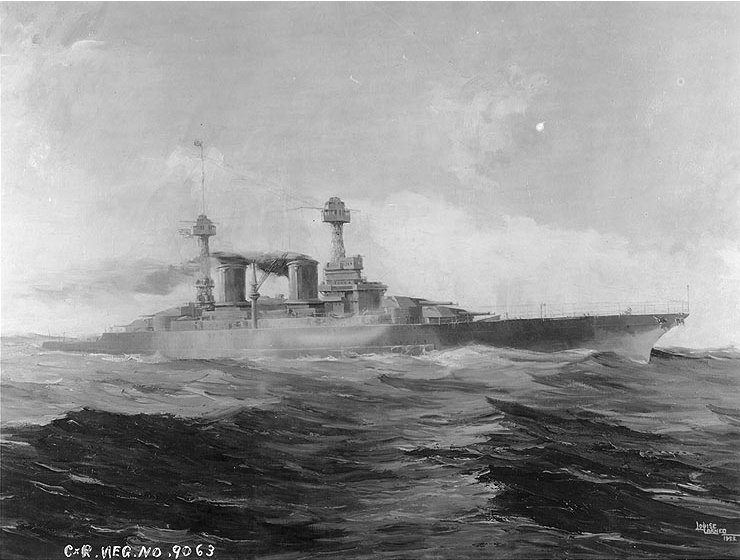
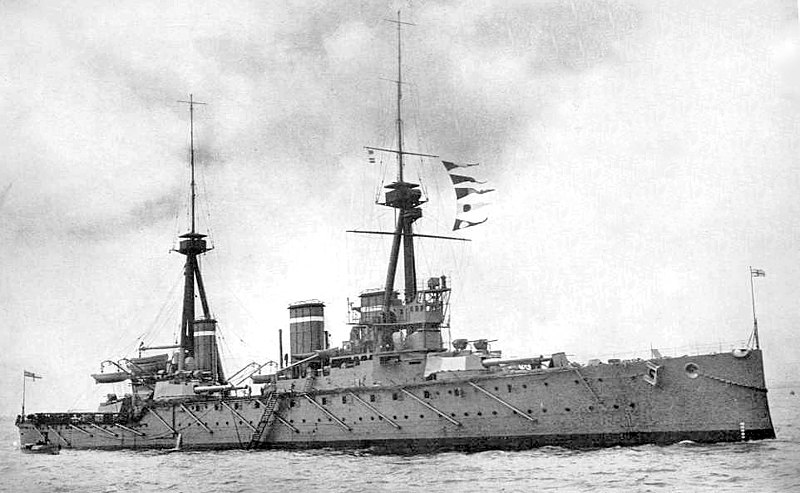
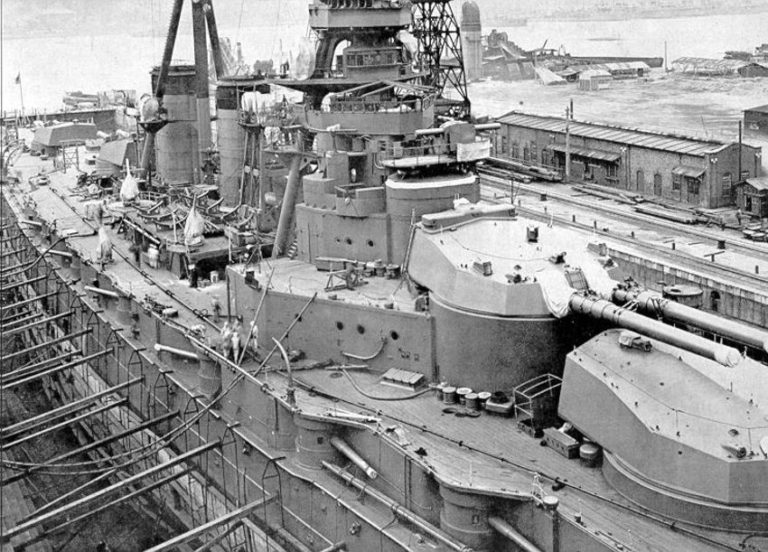
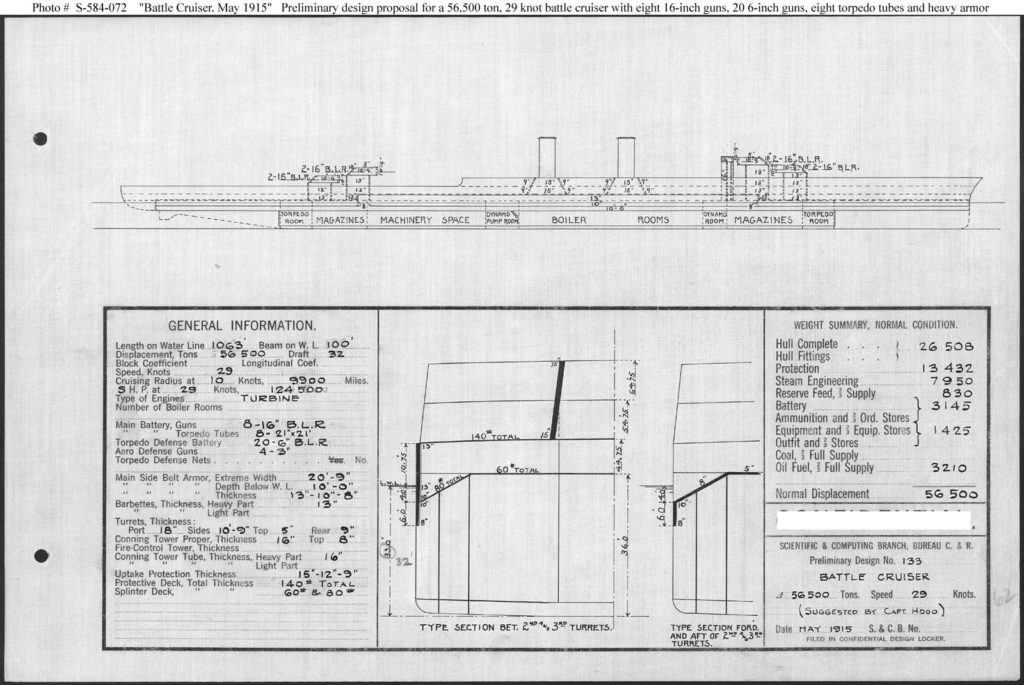
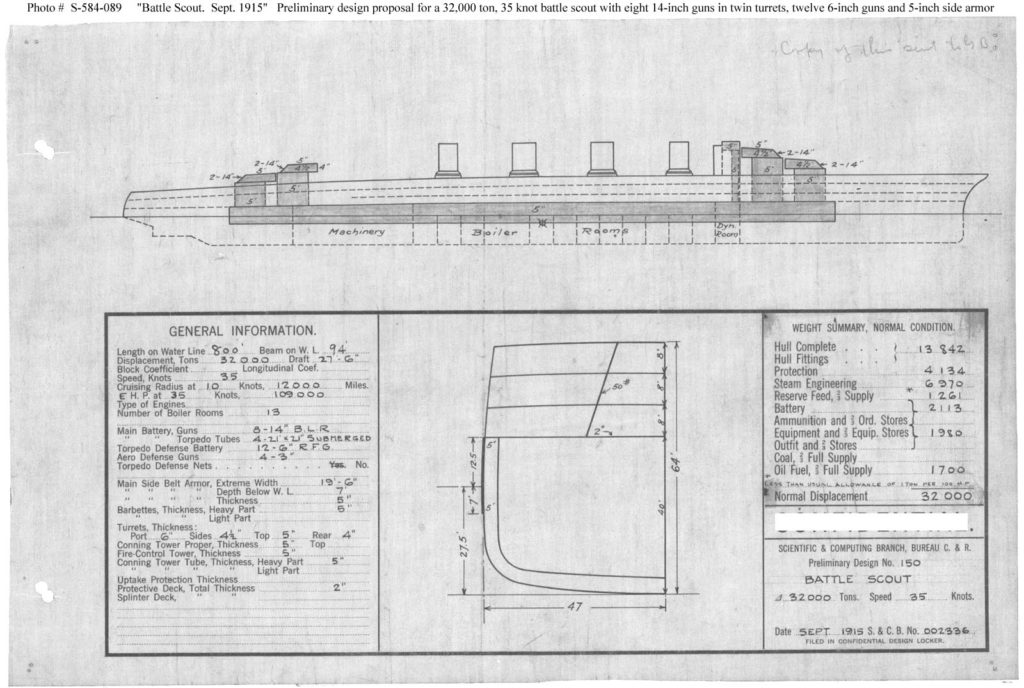
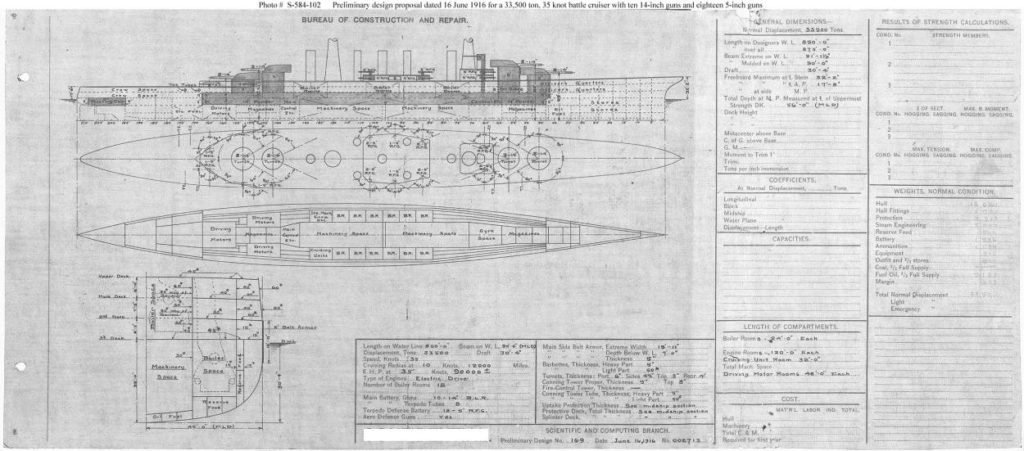

Recent Comments